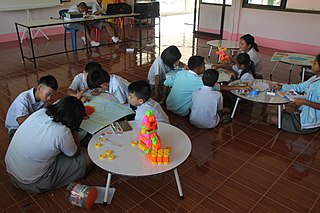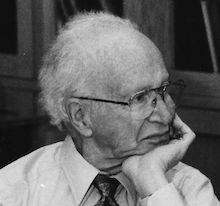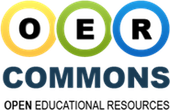An instructional theory is "a theory that offers explicit guidance on how to better help people learn and develop." It provides insights about what is likely to happen and why with respect to different kinds of teaching and learning activities while helping indicate approaches for their evaluation. Instructional designers focus on how to best structure material and instructional behavior to facilitate learning.

A tutorial, in education, is a method of transferring knowledge and may be used as a part of a learning process. More interactive and specific than a book or a lecture, a tutorial seeks to teach by example and supply the information to complete a certain task.

In contemporary education, mathematics education—known in Europe as the didactics or pedagogy of mathematics—is the practice of teaching, learning, and carrying out scholarly research into the transfer of mathematical knowledge.

Problem-based learning (PBL) is a student-centered pedagogy in which students learn about a subject through the experience of solving an open-ended problem found in trigger material. The PBL process does not focus on problem solving with a defined solution, but it allows for the development of other desirable skills and attributes. This includes knowledge acquisition, enhanced group collaboration and communication.
The Association of College and Research Libraries defines information literacy as a "set of integrated abilities encompassing the reflective discovery of information, the understanding of how information is produced and valued and the use of information in creating new knowledge and participating ethically in communities of learning". In the United Kingdom, the Chartered Institute of Library and Information Professionals' definition also makes reference to knowing both "when" and "why" information is needed.
Blended learning or hybrid learning, also known as technology-mediated instruction, web-enhanced instruction, or mixed-mode instruction, is an approach to education that combines online educational materials and opportunities for interaction online with physical place-based classroom methods.

Open educational resources (OER) are teaching, learning, and research materials intentionally created and licensed to be free for the end user to own, share, and in most cases, modify. The term "OER" describes publicly accessible materials and resources for any user to use, re-mix, improve, and redistribute under some licenses. These are designed to reduce accessibility barriers by implementing best practices in teaching and to be adapted for local unique contexts.

Project-based learning (PBL) is a student-centered pedagogy that involves a dynamic classroom approach in which it is believed that students acquire a deeper knowledge through active exploration of real-world challenges and problems. Students learn about a subject by working for an extended period of time to investigate and respond to a complex question, challenge, or problem. It is a style of active learning and inquiry-based learning. PBL contrasts with paper-based, rote memorization, or teacher-led instruction that presents established facts or portrays a smooth path to knowledge by instead posing questions, problems, or scenarios.
A learning management system (LMS) is a software application for the administration, documentation, tracking, reporting, automation, and delivery of educational courses, training programs, materials or learning and development programs. The learning management system concept emerged directly from e-Learning. Learning management systems make up the largest segment of the learning system market. The first introduction of the LMS was in the late 1990s. Learning management systems have faced a massive growth in usage due to the emphasis on remote learning during the COVID-19 pandemic.
A lesson plan is a teacher's detailed description of the course of instruction or "learning trajectory" for a lesson. A daily lesson plan is developed by a teacher to guide class learning. Details will vary depending on the preference of the teacher, subject being covered, and the needs of the students. There may be requirements mandated by the school system regarding the plan. A lesson plan is the teacher's guide for running a particular lesson, and it includes the goal, how the goal will be reached and a way of measuring how well the goal was reached.
Mastery learning is an instructional strategy and educational philosophy, first formally proposed by Benjamin Bloom in 1968. Mastery learning maintains that students must achieve a level of mastery in prerequisite knowledge before moving forward to learn subsequent information. If a student does not achieve mastery on the test, they are given additional support in learning and reviewing the information and then tested again. This cycle continues until the learner accomplishes mastery, and they may then move on to the next stage. In a self-paced online learning environment, students study the material and take assessments. If they make mistakes, the system provides insightful explanations and directs them to revisit the relevant sections. They then answer different questions on the same material, and this cycle repeats until they reach the established mastery threshold. Only then can they move on to subsequent learning modules, assessments, or certifications.

Core-Plus Mathematics is a high school mathematics program consisting of a four-year series of print and digital student textbooks and supporting materials for teachers, developed by the Core-Plus Mathematics Project (CPMP) at Western Michigan University, with funding from the National Science Foundation. Development of the program started in 1992. The first edition, entitled Contemporary Mathematics in Context: A Unified Approach, was completed in 1995. The third edition, entitled Core-Plus Mathematics: Contemporary Mathematics in Context, was published by McGraw-Hill Education in 2015.

Evan Ira Farber was Faculty Emeritus and former Head Librarian at Earlham College. Throughout his career, he was active with the American Library Association (ALA) and the Association of College and Research Libraries (ACRL), holding positions that included Chair of the ACRL College Library Section from 1968 to 1969 and President of the ACRL from 1978 to 1979. He was also active with the ACRL College Leadership Committee and the ACRL College Libraries Mentor Program.
Constructive alignment is a principle used for devising teaching and learning activities, and assessment tasks, that directly address the intended learning outcomes (ILOs) in a way not typically achieved in traditional lectures, tutorial classes and examinations. Constructive alignment was devised by Professor John B. Biggs, and represents a marriage between a constructivist understanding of the nature of learning, and an aligned design for outcomes-based teaching education.
Online tutoring is the process of tutoring in an online, virtual, or networked, environment, in which teachers and learners participate from separate physical locations. Aside from space, participants can also be separated by time.
Visionlearning is a free, web-based resource for students and educators in the science, technology, engineering and mathematics (STEM) disciplines. Geared toward those studying at high school and undergraduate levels, Visionlearning takes advantage of recent advances in new media to provide students and educators with learning and teaching materials. Research by project personnel has shown that this peer-reviewed and bilingual content improves student understanding of science and facilitates multidisciplinary teaching. The project also strives to build community around improving STEM education.
A distance education librarian or distance learning librarian is a specialized academic librarian whose primary duties involve serving the information needs of distance education students, faculty, and staff. This position typically involves coordinating the duties of many librarians and library staff to ensure adequate access to library resources for those who enroll in and teach distance education courses.
MERLOT is an online repository and international consortium of institutions of higher education, industry partners, professional organizations, and individuals. MERLOT partners and members are devoted to identifying, peer reviewing, organizing, and making available existing online learning resources in a range of academic disciplines for use by higher education faculty and students.

OER Commons is a freely accessible online library that allows teachers and others to search and discover open educational resources (OER) and other freely available instructional materials.
Daniel Zingaro is an associate professor at the University of Toronto Mississauga. His main areas of research are in evaluating Computer science education and online learning. He has co-authored over 80 articles in peer-reviewed journals and conferences; and also authored a textbook, "Invariants: a Generative Approach to Programming.








